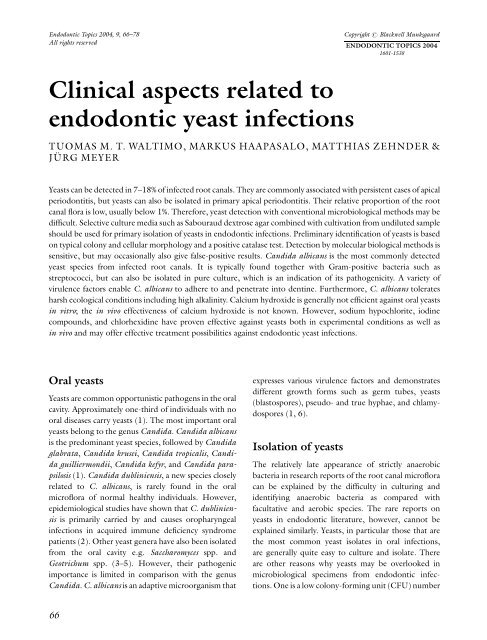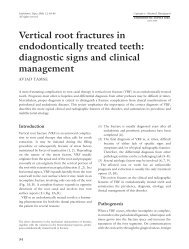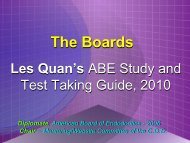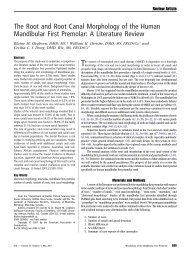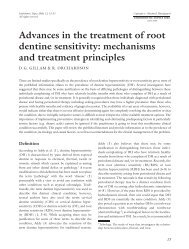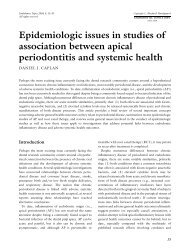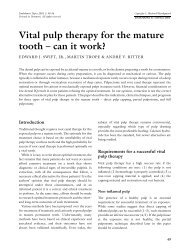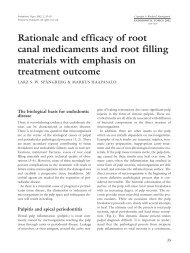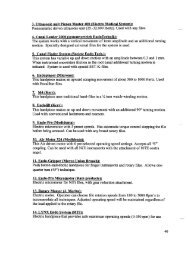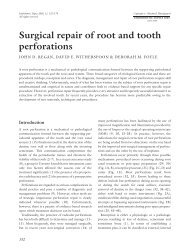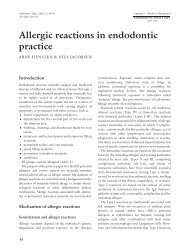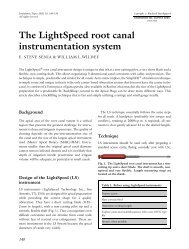Clinical aspects related to endodontic yeast infections - College of ...
Clinical aspects related to endodontic yeast infections - College of ...
Clinical aspects related to endodontic yeast infections - College of ...
Create successful ePaper yourself
Turn your PDF publications into a flip-book with our unique Google optimized e-Paper software.
Endodontic Topics 2004, 9, 66–78<br />
All rights reserved<br />
Copyright r Blackwell Munksgaard<br />
ENDODONTIC TOPICS 2004<br />
1601-1538<br />
<strong>Clinical</strong> <strong>aspects</strong> <strong>related</strong> <strong>to</strong><br />
<strong>endodontic</strong> <strong>yeast</strong> <strong>infections</strong><br />
TUOMAS M. T. WALTIMO, MARKUS HAAPASALO, MATTHIAS ZEHNDER &<br />
JÜRG MEYER<br />
Yeasts can be detected in 7–18% <strong>of</strong> infected root canals. They are commonly associated with persistent cases <strong>of</strong> apical<br />
periodontitis, but <strong>yeast</strong>s can also be isolated in primary apical periodontitis. Their relative proportion <strong>of</strong> the root<br />
canal flora is low, usually below 1%. Therefore, <strong>yeast</strong> detection with conventional microbiological methods may be<br />
difficult. Selective culture media such as Sabouraud dextrose agar combined with cultivation from undiluted sample<br />
should be used for primary isolation <strong>of</strong> <strong>yeast</strong>s in <strong>endodontic</strong> <strong>infections</strong>. Preliminary identification <strong>of</strong> <strong>yeast</strong>s is based<br />
on typical colony and cellular morphology and a positive catalase test. Detection by molecular biological methods is<br />
sensitive, but may occasionally also give false-positive results. Candida albicans is the most commonly detected<br />
<strong>yeast</strong> species from infected root canals. It is typically found <strong>to</strong>gether with Gram-positive bacteria such as<br />
strep<strong>to</strong>cocci, but can also be isolated in pure culture, which is an indication <strong>of</strong> its pathogenicity. A variety <strong>of</strong><br />
virulence fac<strong>to</strong>rs enable C. albicans <strong>to</strong> adhere <strong>to</strong> and penetrate in<strong>to</strong> dentine. Furthermore, C. albicans <strong>to</strong>lerates<br />
harsh ecological conditions including high alkalinity. Calcium hydroxide is generally not efficient against oral <strong>yeast</strong>s<br />
in vitro; the in vivo effectiveness <strong>of</strong> calcium hydroxide is not known. However, sodium hypochlorite, iodine<br />
compounds, and chlorhexidine have proven effective against <strong>yeast</strong>s both in experimental conditions as well as<br />
in vivo and may <strong>of</strong>fer effective treatment possibilities against <strong>endodontic</strong> <strong>yeast</strong> <strong>infections</strong>.<br />
Oral <strong>yeast</strong>s<br />
Yeasts are common opportunistic pathogens in the oral<br />
cavity. Approximately one-third <strong>of</strong> individuals with no<br />
oral diseases carry <strong>yeast</strong>s (1). The most important oral<br />
<strong>yeast</strong>s belong <strong>to</strong> the genus Candida. Candida albicans<br />
is the predominant <strong>yeast</strong> species, followed by Candida<br />
glabrata, Candida krusei, Candida tropicalis, Candida<br />
guilliermondii, Candida kefyr, and Candida parapsilosis<br />
(1). Candida dubliniensis, a new species closely<br />
<strong>related</strong> <strong>to</strong> C. albicans, is rarely found in the oral<br />
micr<strong>of</strong>lora <strong>of</strong> normal healthy individuals. However,<br />
epidemiological studies have shown that C. dubliniensis<br />
is primarily carried by and causes oropharyngeal<br />
<strong>infections</strong> in acquired immune deficiency syndrome<br />
patients (2). Other <strong>yeast</strong> genera have also been isolated<br />
from the oral cavity e.g. Saccharomyces spp. and<br />
Geotrichum spp. (3–5). However, their pathogenic<br />
importance is limited in comparison with the genus<br />
Candida. C. albicans is an adaptive microorganism that<br />
expresses various virulence fac<strong>to</strong>rs and demonstrates<br />
different growth forms such as germ tubes, <strong>yeast</strong>s<br />
(blas<strong>to</strong>spores), pseudo- and true hyphae, and chlamydospores<br />
(1, 6).<br />
Isolation <strong>of</strong> <strong>yeast</strong>s<br />
The relatively late appearance <strong>of</strong> strictly anaerobic<br />
bacteria in research reports <strong>of</strong> the root canal micr<strong>of</strong>lora<br />
can be explained by the difficulty in culturing and<br />
identifying anaerobic bacteria as compared with<br />
facultative and aerobic species. The rare reports on<br />
<strong>yeast</strong>s in <strong>endodontic</strong> literature, however, cannot be<br />
explained similarly. Yeasts, in particular those that are<br />
the most common <strong>yeast</strong> isolates in oral <strong>infections</strong>,<br />
are generally quite easy <strong>to</strong> culture and isolate. There<br />
are other reasons why <strong>yeast</strong>s may be overlooked in<br />
microbiological specimens from <strong>endodontic</strong> <strong>infections</strong>.<br />
One is a low colony-forming unit (CFU) number<br />
66
Endodontic <strong>yeast</strong> <strong>infections</strong><br />
as compared with bacteria. Peciuliene et al. (7) reported<br />
that <strong>yeast</strong>s constituted only o1% <strong>of</strong> the <strong>to</strong>tal cultivable<br />
flora in most specimens. In clinical labora<strong>to</strong>ries,<br />
colonies for preparing pure cultures are usually selected<br />
from plates with 5–50 CFU after serial dilutions.<br />
Despite their presence in the original sample, <strong>yeast</strong><br />
colonies may no longer be found on the plates used for<br />
further culturing. In addition, on non-selective media,<br />
<strong>yeast</strong>s may be disregarded as contaminants as their<br />
colony morphology on the plate resembles that <strong>of</strong><br />
typical contaminants from the air or other sources.<br />
The prepara<strong>to</strong>ry procedures for adequate sampling<br />
include mechanical cleaning <strong>of</strong> the <strong>to</strong>oth with pumice,<br />
e.g., followed by isolation with a rubber dam, and<br />
disinfection <strong>of</strong> the <strong>to</strong>oth surface and the rubber dam<br />
according <strong>to</strong> established procedures (8). Strict asepsis is<br />
crucial at each step, including disinfection <strong>of</strong> the<br />
dentine cavity before trepanation in<strong>to</strong> the pulp<br />
chamber and neutralization <strong>of</strong> the disinfecting solutions<br />
before trepanation. Paper points are usually best<br />
suited for sampling the necrotic root canal. However, as<br />
some brands may be inhibi<strong>to</strong>ry <strong>to</strong> microbial growth<br />
(9), it is recommended that paper points that are<br />
charcoaled or chlor<strong>of</strong>orm washed before sterilization<br />
be used <strong>to</strong> avoid false-negative samples (7, 8, 10).<br />
Yeasts can be best isolated from <strong>endodontic</strong> samples<br />
by using selective media for the primary isolation.<br />
Yeasts <strong>to</strong>lerate a much wider pH range than bacteria,<br />
and therefore several selective media are available for<br />
the isolation <strong>of</strong> <strong>yeast</strong>s. Sabouraud agar is a commonly<br />
used medium for the isolation <strong>of</strong> oral <strong>yeast</strong>s. The pH <strong>of</strong><br />
the medium is quite acidic (usually 5.6), allowing the<br />
growth <strong>of</strong> <strong>yeast</strong>s and aciduric organisms, whereas most<br />
bacteria are inhibited. The pH can be further reduced<br />
by hydrochloric acid <strong>to</strong> 3.0–4.0 <strong>to</strong> prevent the growth<br />
<strong>of</strong> aciduric bacteria. Several different versions <strong>of</strong><br />
Sabouraud agar are available on the market; Sabouraud<br />
dextrose agar is the most frequently used in the<br />
isolation <strong>of</strong> oral <strong>yeast</strong>s. Sometimes, bacterial growth is<br />
further prevented by additives such as chloramphenicol,<br />
strep<strong>to</strong>mycin, novobiocin, penicillin, or other<br />
antibiotics, but this is not necessary for effective<br />
isolation <strong>of</strong> <strong>yeast</strong>s from <strong>endodontic</strong> <strong>infections</strong>. However,<br />
it is important that as much <strong>of</strong> the undiluted<br />
sample is plated as possible <strong>to</strong> ensure detection <strong>of</strong> <strong>yeast</strong>s<br />
in cases where their <strong>to</strong>tal CFU is low (7).<br />
Tryptic soy-serum–bacitracin–vancomycin (TSBV)<br />
medium is a selective medium used primarily for the<br />
isolation <strong>of</strong> Actinobacillus actinomycetemcomitans and<br />
closely <strong>related</strong> Haemophilus spp. (11). Because <strong>of</strong> its<br />
high discriminative power against most other bacteria,<br />
TSBV plates have <strong>of</strong>ten also been used for the primary<br />
isolation <strong>of</strong> oral <strong>yeast</strong>s, which grow well on this medium<br />
(12). However, high numbers <strong>of</strong> Gram-negative<br />
enteric rods, which also grow on TSBV plates, can<br />
hamper the detection <strong>of</strong> <strong>yeast</strong> colonies, which are<br />
typically less numerous if both microbial groups are<br />
present. Therefore, it may be recommended <strong>to</strong> use<br />
Sabouraud dextrose medium, or use both media. TSBV<br />
medium is clearly more expensive because <strong>of</strong> the added<br />
serum. Unfortunately, there are no comparative studies<br />
with a large number <strong>of</strong> clinical samples on the<br />
effectiveness <strong>of</strong> the two media in isolating oral <strong>yeast</strong>s.<br />
It is the experience <strong>of</strong> the authors that when <strong>yeast</strong>s are<br />
the primary research interest, Sabouraud plates should<br />
be the first choice. It should be noted that <strong>yeast</strong>s also<br />
grow on some other selective media, which target<br />
aciduric bacteria, such as Rogosa agar (for the isolation<br />
<strong>of</strong> lac<strong>to</strong>bacilli) and MS agar (for the isolation <strong>of</strong><br />
Strep<strong>to</strong>coccus mutans and other <strong>related</strong> oral strep<strong>to</strong>cocci).<br />
However, these media should not be used<br />
specifically for the isolation <strong>of</strong> oral <strong>yeast</strong>s. Oral <strong>yeast</strong>s<br />
grow best in air at 371C in humid conditions. They<br />
grow poorer in air plus 5% carbon dioxide (optimal for<br />
many facultative bacteria), and may even fail <strong>to</strong> grow<br />
under anaerobic conditions in an anaerobic cabinet or<br />
anaerobic jar, e.g.<br />
Identification <strong>of</strong> <strong>yeast</strong>s<br />
Yeasts grow rapidly on the plates and the colonies can be<br />
picked for biochemical and other tests from overnight<br />
cultures. Yeast colonies are usually white or yellowish,<br />
typically two <strong>to</strong> three times larger than bacterial colonies.<br />
They may have the appearance <strong>of</strong> staphylococcal colonies,<br />
but the surface <strong>of</strong> the colony is usually clearly drier than<br />
that <strong>of</strong> staphylococci. The isolated colonies can be readily<br />
identified as oral <strong>yeast</strong>s by a positive catalase test<br />
(vigorous ‘bubbling’ when dropped in<strong>to</strong> freshly made<br />
3% hydrogen peroxide) and by typical cellular morphology<br />
in wet mount specimens in phase contrast microscopy<br />
(Fig. 1). In Gram stain oral <strong>yeast</strong>s stain intensively<br />
Gram-positive, and the cell size (2.5–5 mm), which is<br />
several times larger than the size <strong>of</strong> bacteria (diameter<br />
0.3–0.7 mm), confirms the preliminary identification.<br />
C. albicans, which is the by far the most common<br />
<strong>yeast</strong> in oral <strong>infections</strong>, including <strong>endodontic</strong><br />
67
Waltimo et al.<br />
Fig. 1. Phase contrast microscopy picture <strong>of</strong> Candida<br />
albicans cells. Typical cell morphology <strong>of</strong> <strong>yeast</strong> cells can be<br />
seen.<br />
<strong>infections</strong>, can be reliably identified by a germ tube test<br />
after preliminary identification (as <strong>yeast</strong>). The germ<br />
tube test for C. albicans is performed by suspending a<br />
low concentration <strong>of</strong> <strong>yeast</strong> cells in small volume <strong>of</strong><br />
serum; commercial germ-tube media are also available.<br />
After 2–3 h <strong>of</strong> incubation, a wet mount is prepared and<br />
examined by phase contrast microscopy at 400. A<br />
germ tube (without septal constrictions) is narrower<br />
but several times longer than the parent cell (13).<br />
For routine diagnostic purposes, oral <strong>yeast</strong>s can be<br />
identified by using commercially available identification<br />
kits. The individual tests in such kits are measuring<br />
fermentation and/or assimilation <strong>of</strong> various carbohydrates<br />
and production <strong>of</strong> a variety <strong>of</strong> glycosidase and<br />
aminopeptidase enzymes (14–16). While most Candida<br />
spp. and other oral <strong>yeast</strong> taxa can be reliably<br />
identified by these test systems, C. dubliniensis remains<br />
a challenge. However, the new kits can with relative<br />
certainty differentiate also between C. albicans and C.<br />
dubliniensis (15, 16).<br />
Kurzai et al. (17) reported that the formation <strong>of</strong><br />
chlamydospores on Staib agar was found with C.<br />
dubliniensis strains but not with C. albicans, suggesting<br />
that this is an easy <strong>to</strong> do, reliable test for differentiating<br />
between the two species. The authors reported a 100%<br />
sensitivity and specificity <strong>of</strong> the chlamydospore test on<br />
Staib agar, identical <strong>to</strong> rDNA sequencing and discriminative<br />
polymerase chain reaction (PCR), which both<br />
had been previously shown <strong>to</strong> be reliable methods <strong>to</strong><br />
differentiate between the two closely <strong>related</strong> species<br />
(18). Recently, Khan et al. (19) showed that C. albicans<br />
and C. dubliniensis can be identified by differences in<br />
colony morphology on sunflower seed agar. The results<br />
<strong>of</strong> the phenotypic tests were confirmed by semi-nested<br />
PCR amplification <strong>of</strong> rDNA using species-specific<br />
primers, followed by direct sequencing <strong>of</strong> the product<br />
(19). The suitability <strong>of</strong> sunflower seed agar in the<br />
differentiation <strong>of</strong> C. albicans and C. dubliniensis has<br />
also been shown by Al Mosaid et al. (20).<br />
Chromogenic media are based on selective <strong>yeast</strong><br />
media supplemented with special chromogenic substrates<br />
<strong>to</strong> give a specific color <strong>to</strong> the different <strong>yeast</strong><br />
species. Comparative studies indicate that these media<br />
can be used even for primary isolation <strong>of</strong> <strong>yeast</strong>s from<br />
clinical samples (21, 22). However, while chromogenic<br />
media are useful for preliminary identification <strong>of</strong> <strong>yeast</strong>s,<br />
they cannot differentiate between all species, including<br />
C. albicans and C. dubliniensis.<br />
Phenotypic characterization is in many cases a valid<br />
and sufficient method for the identification <strong>of</strong> oral<br />
<strong>yeast</strong>s. However, sometimes it may be necessary <strong>to</strong> use<br />
methods based on the DNA analysis <strong>of</strong> the isolated<br />
<strong>yeast</strong> species and strains. Such methods include<br />
arbitrarily primed PCR (23), species-specific DNA<br />
probes (24, 25), and use <strong>of</strong> real-time LightCycler<br />
PCR (26, 27). Recently, Luo & Mitchell (28) reported<br />
successful use <strong>of</strong> multiplex PCR for rapid identification<br />
<strong>of</strong> pathogenic fungi directly from cultures. The authors<br />
were able <strong>to</strong> amplify DNA directly from the <strong>yeast</strong><br />
colonies, thus avoiding the steps needed for purifying<br />
genomic DNA.<br />
Yeasts in root canal <strong>infections</strong><br />
Throughout the past decades, it has been well known<br />
that <strong>yeast</strong>s can be isolated from infected root canals (10,<br />
29–41). The occurrence <strong>of</strong> <strong>yeast</strong>s reported in infected<br />
root canals varies between 1% and 17% (30, 31, 42). In<br />
a study with an extensive material <strong>of</strong> 967 microbiological<br />
samples taken from persistent cases <strong>of</strong> apical<br />
periodontitis, <strong>yeast</strong>s were isolated from 7% <strong>of</strong> culturepositive<br />
samples (41). The identification <strong>of</strong> <strong>yeast</strong>s was<br />
carried out with conventional clinical labora<strong>to</strong>ry<br />
procedures. Almost all isolates belonged <strong>to</strong> the genus<br />
Candida, and C. albicans was the predominant species.<br />
C. glabrata, C. guilliermondii, C. inconspicua, and<br />
Geotrichum candidum were also isolated.<br />
In a study <strong>of</strong> 100 previously root-filled teeth with<br />
apical periodontitis, Molander et al. (10) isolated C.<br />
albicans in three root canals (3%). However, selective<br />
68
Endodontic <strong>yeast</strong> <strong>infections</strong><br />
media for <strong>yeast</strong>s were not used in this study. The<br />
authors also investigated the microbial flora in 20 cases<br />
<strong>of</strong> previously root-filled teeth with an unsatisfac<strong>to</strong>ry<br />
root filling but no periapical lesion and found C.<br />
albicans in two root canals. Sundqvist et al. (43) found<br />
<strong>yeast</strong>s (C. albicans) from two <strong>of</strong> 24 teeth after failing<br />
<strong>endodontic</strong> treatment. Hancock et al. (44) studied the<br />
micr<strong>of</strong>lora in 54 root-filled teeth with persistent<br />
periapical radiolucencies. They found growth in 34<br />
teeth; C. albicans was isolated from one <strong>to</strong>oth. Selective<br />
media for <strong>yeast</strong>s were not used. Pinheiro et al. (45)<br />
studied the flora in 60 root-filled teeth with persisting<br />
periapical lesion. Microorganisms were isolated from<br />
51 teeth, and Candida spp. from two teeth. Also, in<br />
this study, selective <strong>yeast</strong> media were not used.<br />
Peciuliene et al. (7) studied the occurrence <strong>of</strong> <strong>yeast</strong>s,<br />
enteric Gram-negative rods, and Enterococcus spp. in<br />
root-filled teeth with chronic apical periodontitis. Forty<br />
teeth were included in the study, and growth was<br />
detected in 33 teeth using conventional culturing<br />
methods including selective media for <strong>yeast</strong>s (TSBV<br />
and Sabouraud plates). Yeasts were isolated from six<br />
teeth (18% <strong>of</strong> the culture-positive teeth). All isolates<br />
belonged <strong>to</strong> the species C. albicans. Egan et al. (46)<br />
investigated 60 root canal samples in teeth with apical<br />
periodontitis (25 root filled, 35 untreated) using<br />
selective media (Sabouraud dextrose agar), and reported<br />
eight <strong>yeast</strong> isolates in six teeth. Six <strong>of</strong> the isolates<br />
were C. albicans while two were identified as Rodo<strong>to</strong>rula<br />
mucilaginosa. A commercial biochemical test kit<br />
was used for the identification <strong>of</strong> the <strong>yeast</strong>s (46). The<br />
authors also showed that the probability <strong>to</strong> have <strong>yeast</strong>s<br />
in the root canal was 13.8 times higher, when the<br />
patient had cultivable <strong>yeast</strong>s in saliva, the difference<br />
being statistically significant. Previous root canal<br />
treatment, coronal leakage, or previous antibiotic<br />
therapy did not seem <strong>to</strong> have an association with the<br />
occurrence <strong>of</strong> <strong>yeast</strong>s. Cheung & Ho (47), using<br />
selective <strong>yeast</strong> culture media, found microbial growth<br />
in 12 <strong>of</strong> 18 teeth, two with C. albicans.<br />
Although the number <strong>of</strong> studies <strong>of</strong> <strong>yeast</strong>s in<br />
<strong>endodontic</strong> <strong>infections</strong> as well as the number <strong>of</strong> cases<br />
in several <strong>of</strong> the studies is relatively low, it seems that the<br />
frequency <strong>of</strong> isolation <strong>of</strong> <strong>yeast</strong>s is less than 5% when<br />
selective <strong>yeast</strong> media have not been used. However,<br />
when selective <strong>yeast</strong> culture media have been used for<br />
primary isolation, <strong>yeast</strong>s can be found in 7–18% <strong>of</strong> the<br />
teeth. Whether there is a difference between teeth with<br />
apical periodontitis with and without previous root<br />
canal treatment remains unclear at present because <strong>of</strong><br />
the low number <strong>of</strong> comparative studies specifically<br />
focusing on the isolation <strong>of</strong> <strong>yeast</strong>s.<br />
Diagnostic procedures using molecular techniques<br />
have a higher sensitivity than conventional culturing<br />
techniques. Higher numbers <strong>of</strong> microbial species,<br />
including novel taxa, have been identified from root<br />
canals using PCR-based molecular detection techniques<br />
(48). In a study on randomly selected patients<br />
with periapical radiolucencies, C. albicans was detected<br />
by PCR technics in five out <strong>of</strong> 24 samples (21%) taken<br />
from infected root canals <strong>of</strong> teeth with primary apical<br />
periodontitis (42). In the same study, samples were also<br />
collected from 19 cases <strong>of</strong> cellulitis/abscesses using<br />
needle aspirates. All 19 samples were found <strong>to</strong> be<br />
negative for the presence <strong>of</strong> C. albicans DNA. Contrary<br />
<strong>to</strong> the root canal samples in the previous study, Siqueira<br />
et al. (49), using group-specific primers and PCR,<br />
found fungi in only one <strong>of</strong> 91 root canal samples taken<br />
from primary apical periodontitis.<br />
Further studies with larger numbers <strong>of</strong> patients are<br />
necessary <strong>to</strong> confirm these findings. However, it is<br />
important <strong>to</strong> bear in mind that DNA techniques using<br />
PCR <strong>to</strong> multiply part <strong>of</strong> the microbial genome cannot<br />
discern between dead material and living organisms.<br />
Therefore, the goals <strong>of</strong> the investigation should, <strong>to</strong><br />
some extent, guide the choice <strong>of</strong> techniques used for<br />
the detection <strong>of</strong> microorganisms in <strong>endodontic</strong> <strong>infections</strong>.<br />
When the primary goal is <strong>to</strong> find out which<br />
microorganisms are or have been present in the root<br />
canal, sensitive molecular methods may give maximum<br />
information. However, when the sample is taken <strong>to</strong><br />
help in planning effective treatment strategy in individual<br />
cases, culture methods should be given priority, as<br />
they reveal the viability <strong>of</strong> the detected organisms.<br />
Mixed <strong>infections</strong><br />
C. albicans can occasionally be found in pure culture in<br />
the root canal. However, <strong>yeast</strong>s are usually isolated in<br />
mixed <strong>infections</strong> <strong>to</strong>gether with bacteria. Facultative<br />
Gram-positive bacteria such as a- and non-hemolytic<br />
Strep<strong>to</strong>coccus species are commonly found <strong>to</strong>gether with<br />
<strong>yeast</strong>s, whereas Gram-negative isolates are rare (41). It is<br />
possible that ecological conditions in the necrotic root<br />
canals favor the growth and coexistence <strong>of</strong> <strong>yeast</strong>s and<br />
strep<strong>to</strong>cocci. In addition, C. albicans coaggregates with<br />
a variety <strong>of</strong> strep<strong>to</strong>cocci such as Strep<strong>to</strong>coccus gordonii,<br />
69
Waltimo et al.<br />
Strep<strong>to</strong>coccus mutans,andStrep<strong>to</strong>coccus sanguis (50, 51),<br />
which may facilitate bi<strong>of</strong>ilm formation. Bi<strong>of</strong>ilms again<br />
are known <strong>to</strong> promote colonization and survival <strong>of</strong><br />
individual taxa, further explaining the concomitant<br />
occurrence <strong>of</strong> <strong>yeast</strong>s and strep<strong>to</strong>cocci in necrotic root<br />
canals (52).<br />
Dentine infection and virulence<br />
fac<strong>to</strong>rs<br />
Microscopic examination <strong>of</strong> extracted teeth associated<br />
with apical periodontitis and in vitro investigations on<br />
the ability <strong>of</strong> <strong>yeast</strong>s <strong>to</strong> adhere and invade dentine have<br />
increased our knowledge about <strong>yeast</strong>s in root canal<br />
<strong>infections</strong> (Figs 2–4). Nair et al. (36) provided evidence<br />
<strong>of</strong> the presence <strong>of</strong> <strong>yeast</strong>-like organisms, in addition <strong>to</strong><br />
Fig. 2. Scanning electron micrograph <strong>of</strong> budding <strong>yeast</strong><br />
cells in pure culture on root canal wall. (bar remarks<br />
10 mm).<br />
Fig. 3. Yeast infection <strong>of</strong> dentin. Some dentinal tubules<br />
are infected whereas the majority <strong>of</strong> the tubules remain<br />
free <strong>of</strong> cells.<br />
Fig. 4. Candida albicans adhering and invading in<strong>to</strong> a<br />
dentinal tubule.<br />
bacteria, in the root canal and apical foramen using<br />
light and electron microscopy. The organisms found<br />
had the typical size and cellular appearance <strong>of</strong> fungal<br />
organisms including distinct cell wall, nuclei, and<br />
budding growth forms indicating proliferation <strong>of</strong> the<br />
cells. In this study, the presence <strong>of</strong> intraradicular fungi<br />
in <strong>endodontic</strong>ally treated human teeth was associated<br />
with periapical lesions that persisted after root canal<br />
therapy. Further observations on bacteria and fungi<br />
using scanning electron microscopy in infected root<br />
canals and dentinal tubules associated with periapical<br />
lesions were made by Sen et al. (38). They found root<br />
canals heavily infected with <strong>yeast</strong>s in ovoid and hyphal<br />
forms. In subsequent studies, Sen et al. (39) investigated<br />
the growth patterns <strong>of</strong> C. albicans on native and<br />
chemically modified dental hard tissues. Yeast cells were<br />
allowed <strong>to</strong> attach <strong>to</strong> or grow on enamel, cement, and<br />
dentine, with or without previous treatment by<br />
ethylendiamine tetra-acetic acid EDTA and sodium<br />
hypochlorite. C. albicans was grown in the presence <strong>of</strong><br />
serum before the experiments. The authors found no<br />
difference in the growth pattern <strong>of</strong> C. albicans between<br />
enamel and cement. Pretreatment with EDTA/NaOCl<br />
had no effect on the results. A bi<strong>of</strong>ilm consisting <strong>of</strong><br />
<strong>yeast</strong>s and C. albicans hyphae was consistently detected<br />
on these two dental hard tissues. The surfaces were<br />
covered with separate, but dense colonies. In dentine<br />
specimens with a smear layer, the colonies were not<br />
distinct and presented a dense mass <strong>of</strong> <strong>yeast</strong> cells and<br />
mycelia, forming a bi<strong>of</strong>ilm. No dense colonies could be<br />
detected in the absence <strong>of</strong> a smear layer. In many areas,<br />
the hyphae were seen <strong>to</strong> penetrate in<strong>to</strong> dentinal<br />
tubules, accompanied by single <strong>yeast</strong> cells. The<br />
observations suggested that the presence <strong>of</strong> smear layer<br />
70
Endodontic <strong>yeast</strong> <strong>infections</strong><br />
favors the growth and attachment <strong>of</strong> C. albicans <strong>to</strong> root<br />
dentine (40). Compared with other oral <strong>yeast</strong> species,<br />
C. albicans seems <strong>to</strong> have superior properties for<br />
dentine colonization and infection. Together with its<br />
predominant occurrence in the oral cavity, this may<br />
explain its isolation also from root canal <strong>infections</strong> (53).<br />
The presence <strong>of</strong> oral <strong>yeast</strong>s in carious lesions has been<br />
known for a long time (54, 55). However, the dynamics<br />
<strong>of</strong> <strong>yeast</strong> invasion in<strong>to</strong> dentinal tubules is largely<br />
unknown. Recently, an in vitro method was developed<br />
<strong>to</strong> study the penetration in<strong>to</strong> human dentine by C.<br />
albicans and Enterococcus faecalis (56). Both macroscopic<br />
recording <strong>of</strong> the penetration through dentine<br />
discs and microscopic examination <strong>of</strong> microorganisms<br />
in dentinal tubules were performed. C. albicans growth<br />
in<strong>to</strong> dentinal tubules was relatively weak in comparison<br />
with E. faecalis. However, both organisms were able <strong>to</strong><br />
penetrate through a 2 mm thick human dentine disc.<br />
His<strong>to</strong>logical preparations showed penetration <strong>of</strong> ovoid<br />
or budding <strong>yeast</strong> cells as well as hyphae in<strong>to</strong> a few<br />
dentinal tubules, whereas most <strong>of</strong> the tubules remained<br />
free <strong>of</strong> cells. Continuous penetration could be seen up<br />
<strong>to</strong> a depth <strong>of</strong> 60 mm. Beyond that, single budding cells<br />
in low numbers could be found throughout the dentine<br />
specimens. It is worth noting, however, that the<br />
dentinal canals were patent throughout the specimen<br />
and not blocked by a layer <strong>of</strong> cement, e.g. A<br />
corresponding situation where the cement layer is<br />
missing is known <strong>to</strong> occur at the root tip area in chronic<br />
apical periodontitis, where resorption <strong>of</strong> some areas <strong>of</strong><br />
root cement has been documented in his<strong>to</strong>logical<br />
specimens <strong>of</strong> extracted teeth or root tips after<br />
apicoec<strong>to</strong>my (57).<br />
A characteristic feature <strong>of</strong> mycotic <strong>infections</strong> is their<br />
development when the host provides the environmental<br />
conditions and nutrients essential for attachment,<br />
growth, and reproduction <strong>of</strong> fungi. Thus, for mycoses<br />
<strong>to</strong> occur, local and/or general predisposing fac<strong>to</strong>rs are<br />
required. The necrotic pulp space and adjacent dentine,<br />
although a harsh ecological environment, provides<br />
essentials needed for a Candida infection <strong>to</strong> develop.<br />
On the other hand, a variety <strong>of</strong> virulence fac<strong>to</strong>rs such as<br />
adherence, hyphae formation, thigmotropism (contact<br />
sensing) for penetration, protease secretion, and<br />
phenotypic switching are required on the side <strong>of</strong> the<br />
pathogen. Adherence <strong>of</strong> C. albicans <strong>to</strong> dentine and<br />
bi<strong>of</strong>ilm formation are likely <strong>to</strong> increase its resistance <strong>to</strong><br />
antimicrobial agents and changes in the pH. The<br />
capability <strong>to</strong> penetrate in<strong>to</strong> dentinal tubules is based on<br />
pleomorphic growth patterns as well as thigmotropism.<br />
Because <strong>of</strong> these fac<strong>to</strong>rs, the entire root canal system<br />
can be invaded by C. albicans, making its conservative<br />
elimination from dentine difficult, although this has<br />
not been shown in vivo. Aspartyl protease secretion and<br />
enzymes capable <strong>of</strong> degrading dentinal collagen can<br />
further improve the ability <strong>of</strong> C. albicans <strong>to</strong> survive in<br />
limited nutrient conditions. Spontaneous phenotypic<br />
switching may further promote the survival in changing<br />
microecological environment. These fac<strong>to</strong>rs make<br />
Candida species exceptionally adaptive <strong>to</strong> <strong>to</strong>lerate<br />
environmental and nutritional changes during root<br />
canal therapy.<br />
Periradicular <strong>yeast</strong> <strong>infections</strong><br />
Periapical actinomycosis is an <strong>endodontic</strong> infection,<br />
where the bacteria are residing outside the root canal<br />
system in the periapical area. Several different Actinomyces<br />
species have been isolated in the bacterial<br />
macrocolonies from these lesions (58–61). It has been<br />
suggested that some other bacteria may also be<br />
involved in periapical actinomycosis, although it is<br />
not known whether they represent extruded bacterial<br />
colonies during <strong>endodontic</strong> treatment or true actinomyces-like<br />
infection (61, 62).<br />
The information available about the occurrence <strong>of</strong><br />
<strong>yeast</strong>s in the periapical tissues <strong>of</strong> teeth with apical<br />
periodontitis is scarce. Nair et al. (36) analyzed nine<br />
therapy-resistant and asymp<strong>to</strong>matic human periapical<br />
lesions by light and electron microscopy, using block<br />
biopsies that were removed during surgical treatment<br />
<strong>of</strong> the affected teeth. The cases that required surgery<br />
represented about 10% <strong>of</strong> all <strong>of</strong> the cases that received<br />
<strong>endodontic</strong> treatment 4–10 years earlier. Six <strong>of</strong> the nine<br />
biopsies revealed the presence <strong>of</strong> microorganisms in the<br />
apical root canal. Four contained one or more species <strong>of</strong><br />
bacteria and two revealed <strong>yeast</strong>s. However, colonies <strong>of</strong><br />
microorganisms were not detected in the periapical<br />
area. In two other studies, scanning electron microscopy<br />
was used <strong>to</strong> characterize the morphotypes <strong>of</strong><br />
microorganisms present in the root canals <strong>of</strong> teeth with<br />
apical periodontitis (63, 64). While bacteria were found<br />
in great numbers in the root canal, in only one<br />
specimen they had invaded a short distance beyond<br />
the apical foramen. Yeast-like cells were not seen<br />
outside the root canal, but in one specimen <strong>yeast</strong> cells<br />
were detected in the middle third <strong>of</strong> the root canal.<br />
71
Waltimo et al.<br />
Another approach <strong>to</strong> investigate the presence <strong>of</strong> <strong>yeast</strong>s<br />
in the periapical area was taken in a new study where<br />
103 surgically removed periapical granulomas taken<br />
from teeth with apical periodontitis resistant <strong>to</strong> normal<br />
conservative <strong>endodontic</strong> treatment were analyzed (65).<br />
After removal <strong>of</strong> the surface layers (his<strong>to</strong>logical<br />
sections) from the lesions, the material was subjected<br />
<strong>to</strong> DNA extraction and PCR using specific primers <strong>to</strong><br />
oral <strong>yeast</strong>s and controls. DNA could be obtained from<br />
68 lesions and 18 were positive <strong>to</strong> <strong>yeast</strong> PCR. However,<br />
when the PCR products were analyzed by sequencing,<br />
none <strong>of</strong> the 18 PCR products showed DNA sequence<br />
typical for Candida spp. Neither could immunohis<strong>to</strong>logical<br />
examination <strong>of</strong> these 18 samples show any<br />
positive staining indicative <strong>of</strong> Candida infection. The<br />
authors concluded that oral <strong>yeast</strong>s could not be<br />
demonstrated in the periapical tissues <strong>of</strong> the teeth<br />
studied (65).<br />
The previous study clearly demonstrated that even<br />
with modern molecular biological techniques, the risk<br />
<strong>of</strong> false-positive results must be kept in mind. In the<br />
living tissues in the periapical area, ‘false positive’ can<br />
result from cross-reactions, even with specific primers,<br />
or by contamination <strong>of</strong> the sample during extraction or<br />
periapical surgical procedures as indicated by Siqueira<br />
& Lopes (63). Possible pathways <strong>of</strong> contamination <strong>of</strong><br />
the periapical microbiological sample are (i) from the<br />
gingival sulcus (intrasulcular incision, (ii) attached<br />
gingiva and mucosa (submarginal flap), (iii) sinus tract<br />
in the lesion, and (iv) suction <strong>of</strong> canal contents because<br />
<strong>of</strong> underpressure during operation in<strong>to</strong> the periapical<br />
area. Already in 1966, Möller (8) demonstrated the<br />
absence <strong>of</strong> viable microorganisms in resting periradicular<br />
inflamma<strong>to</strong>ry lesions without sinus tract when the<br />
surgical access site was disinfected completely and<br />
isolated with the aid <strong>of</strong> a rubber dam and a cus<strong>to</strong>mized<br />
acrylic shield. Without extreme care, the risk <strong>of</strong><br />
contamination was evident (8). In two newer studies,<br />
bacteriological findings from the periapical area were<br />
compared when either full-thickness intrasulcular<br />
mucoperiosteal or a submarginal flap was performed<br />
in patients with asymp<strong>to</strong>matic apical periodontitis (61,<br />
66). Both studies showed that fewer bacteria were<br />
found from the bone surface samples when a submarginal<br />
flap was used. Using the same technique,<br />
Sunde et al. (67) analyzed the periapical micr<strong>of</strong>lora in<br />
36 teeth with apical periodontitis after 6 months <strong>of</strong><br />
unsuccessful conservative <strong>endodontic</strong> treatment. Periapical<br />
samples were cultured on non-selective and<br />
selective media, including Sabouraud dextrose agar and<br />
TSBV plates, both supporting isolation <strong>of</strong> <strong>yeast</strong>s. C.<br />
albicans was isolated from two cases (6%) with no<br />
evidence <strong>of</strong> a sinus tract. Presently, this report is the<br />
only one indicating the presence <strong>of</strong> <strong>yeast</strong>s in the<br />
periapical area. However, it is important <strong>to</strong> understand<br />
the difference between primary (untreated) apical<br />
periodontitis and persistent lesions. In the latter,<br />
microbes may be pushed in<strong>to</strong> the periapical area during<br />
the treatment procedures (iatrogenic extraradicular<br />
infection), and while the extruded microorganisms<br />
usually cause no or only short-lasting problems (e.g.<br />
flare up), it is possible that occasionally densely packed<br />
microbial colonies from the root canal may be<br />
transferred <strong>to</strong> the periapical area, where their elimination<br />
by host defense can take a long time, or be<br />
unsuccessful.<br />
Treatment strategies<br />
Mechanical preparation does not suffice <strong>to</strong> free a <strong>to</strong>oth<br />
with apical periodontitis from all bacteria in the root<br />
canal (68). Furthermore, s<strong>of</strong>t tissue remnants may be<br />
left behind after mechanical root canal preparation<br />
(69). Collagen and other s<strong>of</strong>t tissue components<br />
provide a source <strong>of</strong> nutrition for microorganisms that<br />
survived root canal therapy, allowing them <strong>to</strong> remultiply<br />
(70). Thus, a so-called ‘chemo-mechanical’<br />
treatment strategy is advocated with the aid <strong>of</strong><br />
antimicrobial and tissue-dissolving irrigants <strong>to</strong> minimize<br />
the amount <strong>of</strong> infected dentine, pulpal remnants,<br />
and the number <strong>of</strong> microorganisms in the root canal<br />
system. However, complete disinfection <strong>of</strong> the root<br />
canal system cannot be predictably completed by<br />
chemomechanical preparation alone (71). It is currently<br />
debated whether an interappointment dressing<br />
would further decrease the number <strong>of</strong> viable microbes<br />
in samples from root canal systems. Earlier studies<br />
suggested better root canal disinfection after a calcium<br />
hydroxide dressing for 1–3 weeks subsequent <strong>to</strong><br />
instrumentation and irrigation with sodium hypochlorite<br />
vs. instrumentation/irrigation alone (72, 73).<br />
However, several other studies have found no difference<br />
or have indicated even the opposite (74, 75).<br />
Persistent microorganisms, such as E. faecalis or C.<br />
albicans, are <strong>of</strong>ten present in root canal <strong>infections</strong><br />
resistant <strong>to</strong> conventional therapy. Therefore, attention<br />
should be paid <strong>to</strong> adequate treatment strategies<br />
72
Endodontic <strong>yeast</strong> <strong>infections</strong><br />
including selection <strong>of</strong> medicaments potentially efficient<br />
against microorganisms residing in the root canal<br />
system. In this context, it should be noted that<br />
extended exposure times <strong>to</strong> microbiota increase the<br />
killing efficacy <strong>of</strong> all antiseptic agents (76). Even fastacting<br />
halogen-releasing agents such as sodium hypochlorite<br />
or iodine potassium iodide (IPI) have increased<br />
efficacy with extended working time in the root canal<br />
(74, 77). Thus, whether the aim is <strong>to</strong> finish a root canal<br />
treatment in one or two visits, adequate time should be<br />
given <strong>to</strong> irrigants or intracanal dressings <strong>to</strong> achieve<br />
proper disinfection.<br />
Irrigating solutions<br />
Sodium hypochlorite is probably the most widely used<br />
irrigant in <strong>endodontic</strong>s <strong>to</strong>day. It is a potent disinfectant,<br />
killing microorganisms in concentrations between 0.5%<br />
and 5%, in clinically relevant periods <strong>of</strong> time. It has a<br />
wide antimicrobial spectrum, and is active against C.<br />
albicans. Ferguson et al. (78) determined the susceptibility<br />
<strong>of</strong> C. albicans <strong>to</strong> intracanal irrigating solutions<br />
and locally used disinfecting medicaments. The minimum<br />
inhibi<strong>to</strong>ry concentration (MIC) <strong>of</strong> sodium<br />
hypochlorite, hydrogen peroxide, chlorhexidine digluconate,<br />
and aqueous calcium hydroxide <strong>to</strong> inhibit the<br />
growth <strong>of</strong> C. albicans was determined. Sodium<br />
hypochlorite, hydrogen peroxide, and chlorhexidine<br />
digluconate were effective anticandidal agents with<br />
MICs <strong>of</strong> o10, 234, and o0.63 mg/mL, respectively.<br />
Aqueous calcium hydroxide had no activity. However,<br />
when a standardized inoculum <strong>of</strong> C. albicans cells was<br />
placed in direct contact with calcium hydroxide paste or<br />
camphorated para-monochlorophenol, both were<br />
shown <strong>to</strong> kill the <strong>yeast</strong> cells effectively.<br />
In addition <strong>to</strong> antibacterial properties, sodium hypochlorite<br />
has a unique potential <strong>to</strong> dissolve s<strong>of</strong>t tissue, a<br />
characteristic not found with other <strong>endodontic</strong> irrigants<br />
(79). However, sodium hypochlorite at high concentrations<br />
can be caustic <strong>to</strong> vital periapical or periodontal<br />
tissues, if inadvertently introduced <strong>to</strong> these (80). It is<br />
therefore advocated <strong>to</strong> irrigate root canals with high<br />
volumes <strong>of</strong> a low-concentration solution, i.e. 0.5–1%.<br />
To improve antisepsis in a one-appointment regimen,<br />
it has been suggested <strong>to</strong> rinse/soak the canals with<br />
chlorhexidine or IPI solutions following irrigation with<br />
sodium hypochlorite (7, 74, 81). Aqueous chlorhexidine<br />
solution has a wide-spectrum antimicrobial<br />
activity at low concentrations, and is especially effective<br />
against C. albicans (78). Furthermore, it binds <strong>to</strong><br />
surrounding tissues <strong>to</strong> be released again slowly over<br />
extended periods <strong>of</strong> time (82), a phenomenon called<br />
substantivity. Interestingly, it appears that chlorhexidine<br />
can efficiently inhibit the initial adherence and<br />
perhaps further accumulation and bi<strong>of</strong>ilm formation <strong>of</strong><br />
<strong>yeast</strong>s and other microorganisms (83). A recent clinical<br />
study has shown that canals that received a final rinse<br />
with a 2% chlorhexidine solution were significantly<br />
more <strong>of</strong>ten free <strong>of</strong> cultivable microorganisms than<br />
controls irrigated with sodium hypochlorite alone (81).<br />
However, chlorhexidine preparations have little <strong>to</strong> no<br />
tissue-dissolving capacity (79), and should therefore<br />
only be used after thorough irrigation with sodium<br />
hypochlorite. IPI, used as an intravisit dressing for<br />
10 min, has also shown some promise as an <strong>endodontic</strong><br />
disinfectant. However, iodine preparations may not<br />
<strong>of</strong>fer any additional value against <strong>yeast</strong>s when used in<br />
combination with sodium hypochlorite, because they<br />
have a similar mode <strong>of</strong> action. In addition, IPI may stain<br />
teeth and is potentially allergenic (84).<br />
Removal <strong>of</strong> the smear layer appears <strong>to</strong> improve the<br />
antiseptic action <strong>of</strong> irrigants and intracanal medications<br />
(71, 85). EDTA is the most frequently used chela<strong>to</strong>r in<br />
root canal therapy (86). Antimicrobial efficacy <strong>of</strong> EDTA<br />
has been described, but <strong>to</strong> date, the killing efficacy on<br />
<strong>yeast</strong>s in direct exposure tests in comparison with other<br />
<strong>endodontic</strong>s irrigants remains unclear (87, 88).<br />
Very little data are available about the effectiveness <strong>of</strong><br />
various irrigating solutions or disinfecting agents<br />
against <strong>yeast</strong>s in vivo in the infected root canal.<br />
Peciuliene et al. (7) studied the effect <strong>of</strong> instrumentation<br />
and irrigation in previously root-filled teeth with<br />
apical periodontitis. C. albicans was found in six <strong>of</strong> 33<br />
root canals before starting the preparation. A second<br />
sample taken after instrumentation and irrigation with<br />
10 mL <strong>of</strong> 2.5% NaOCl and 5 mL <strong>of</strong> 17% EDTA revealed<br />
no <strong>yeast</strong>s in any <strong>of</strong> the canals. In the same study, E.<br />
faecalis was still present in six canals (originally found in<br />
20 canals) after the chemomechanical preparation<br />
described above. The result is an indication that<br />
eradication <strong>of</strong> C. albicans from the root canal in vivo is<br />
an achievable goal with a routine pro<strong>to</strong>col as described.<br />
Disinfecting interappointment medicament:<br />
calcium hydroxide<br />
Calcium hydroxide is the interim root canal medication<br />
<strong>of</strong> choice for many endodontists for various reasons:<br />
73
Waltimo et al.<br />
it has a good antibacterial effect in the infected root<br />
canals (72), dissolves necrotic tissue remnants (89),<br />
and inactivates endo<strong>to</strong>xins (90–92). The antimicrobial<br />
effects <strong>of</strong> calcium hydroxide are assumed <strong>to</strong> be caused<br />
by its high pH and high alkaline buffer capacity. Thus,<br />
calcium hydroxide is not effective against alkaliresistant<br />
microbes such as C. albicans in vitro, unless<br />
the organisms are in direct contact with calcium<br />
hydroxide paste. In a recent report (93), C. albicans<br />
was found <strong>to</strong> be even more resistant than E. faecalis,<br />
which has shown both clinical and in vitro resistance<br />
against calcium hydroxide (72, 94).<br />
Calcium hydroxide combined with effective aqueous<br />
disinfectants may provide an improved interappointment<br />
dressing, with an extended antimicrobial spectrum<br />
also covering persistent microorganisms such as<br />
C. albicans (95). It has been shown that combinations<br />
<strong>of</strong> calcium hydroxide with sodium hypochlorite or<br />
chlorhexidine solutions maintain the alkaline capacity<br />
<strong>of</strong> aqueous calcium hydroxide suspensions (96), while<br />
their efficacy in disinfecting dentinal tubules is improved<br />
(97). Sirén et al. (98) have also shown superior<br />
disinfecting effect <strong>of</strong> calcium hydroxide combined with<br />
either 0.5% chlorhexidine or 2/4% IPI in dentine<br />
blocks infected with E. faecalis. While pure calcium<br />
hydroxide was shown <strong>to</strong> be <strong>to</strong>tally ineffective against E.<br />
faecalis in the dentine, both combination preparations<br />
killed E. faecalis deep in the dentine during the 1 and 7<br />
days test periods. Although the new combinations were<br />
not tested against <strong>yeast</strong>-infected dentine, the effectiveness<br />
<strong>of</strong> both chlorhexidine and iodine against <strong>yeast</strong>s<br />
alone indicates that the combination products would<br />
be more effective against <strong>yeast</strong>s than pure calcium<br />
hydroxide. Interestingly, cy<strong>to</strong><strong>to</strong>xicity experiments<br />
showed that the combination products were less<br />
cy<strong>to</strong><strong>to</strong>xic than each <strong>of</strong> the components alone (98).<br />
However, more clinical studies are needed <strong>to</strong> find out<br />
whether combining calcium hydroxide with antiseptic<br />
irrigants as an interim dressing improves the antimicrobial<br />
effectiveness as compared with irrigation with<br />
these irrigants followed by a conventional calcium<br />
hydroxide dressing.<br />
Antifungal agents<br />
Use <strong>of</strong> local antibiotic agents in root canal infection has<br />
been <strong>of</strong> interest for decades. However, there is no<br />
evidence that antibiotic cocktails would completely<br />
disinfect dentine or give higher clinical success rates.<br />
Neither is there evidence that local antimycotic<br />
substances would give better results than ‘traditional’<br />
local disinfecting agents. Topical antibiotic agents<br />
always cause a local concentration gradient. Microorganisms<br />
residing in dentinal tubules or periapical<br />
lesions exposed <strong>to</strong> sublethal concentrations may therefore<br />
develop resistance. Therefore, fungal antibiotics<br />
should be considered locally and systemically only for<br />
the treatment <strong>of</strong> acute apical periodontitis with severe<br />
symp<strong>to</strong>ms after microbiological diagnosis. Intermediate<br />
or resistant <strong>yeast</strong> isolates from infected root canals<br />
against azole-group medicaments have already been<br />
reported (99).<br />
New approaches in dentine<br />
disinfection<br />
Complete disinfection <strong>of</strong> dentine has shown <strong>to</strong> be a<br />
goal that is difficult <strong>to</strong> reach with the presently available<br />
irrigating solutions and local root canal medicaments.<br />
One <strong>of</strong> the reasons for the poorer in vivo effectiveness<br />
as compared with in vitro results is partial or <strong>to</strong>tal<br />
inactivation <strong>of</strong> the antibacterial effect <strong>of</strong> the various<br />
medicaments by dentine and other substances potentially<br />
present in the necrotic root canal environment<br />
(100–102). Therefore, it sounds logical <strong>to</strong> search for<br />
better disinfecting pro<strong>to</strong>cols by combining existing and<br />
even new disinfectants, or <strong>to</strong> find antimicrobial<br />
substances that are not affected or are even potentiated<br />
by dentine instead <strong>of</strong> inhibition. Recent reports have<br />
indicated the potential <strong>of</strong> bioactive glass <strong>of</strong> the SiO 2 –<br />
Na 2 O–CaO–P 2 O 5 system for dentine disinfection<br />
(103). Bioactive glass alone has a moderate disinfecting<br />
potential. Interestingly, the presence <strong>of</strong> dentine in<br />
aqueous suspension appears <strong>to</strong> boost the antimicrobial<br />
activity <strong>of</strong> bio-active glass. However, the findings were<br />
obtained in an in vitro environment, and it is premature<br />
at this point <strong>to</strong> draw far-reaching conclusions regarding<br />
its clinical effectiveness. Nevertheless, this novel<br />
approach <strong>to</strong> dentine disinfection is promising because<br />
<strong>of</strong> the synergistic and not antagonistic interaction with<br />
the host environment.<br />
Conclusions<br />
C. albicans is by far the most common <strong>yeast</strong> in<br />
<strong>endodontic</strong> <strong>infections</strong>. Yeasts can be found in low<br />
74
Endodontic <strong>yeast</strong> <strong>infections</strong><br />
numbers both from primary <strong>infections</strong> as well as from<br />
post-treatment <strong>infections</strong>. The number <strong>of</strong> <strong>yeast</strong> cells in<br />
the root canal is usually much lower than that <strong>of</strong><br />
bacteria, and it is uncertain at present whether <strong>yeast</strong>s<br />
can survive outside the root canal in the periapical area<br />
in ‘extraradicular <strong>infections</strong>’. The ability <strong>of</strong> C. albicans<br />
<strong>to</strong> interact with dentine may be important for its ability<br />
<strong>to</strong> survive in the ecologically demanding environment<br />
<strong>of</strong> the necrotic or treated root canal. Although C.<br />
albicans and other <strong>yeast</strong>s are resistant <strong>to</strong> some locally<br />
used disinfecting agents such as calcium hydroxide<br />
in vitro, there is no solid evidence that their eradication<br />
from the root canal is a clinical problem. C. albicans is<br />
more sensitive <strong>to</strong> sodium hypochlorite than E. faecalis<br />
(104), and it is also rapidly killed by low concentrations<br />
<strong>of</strong> chlorhexidine. In the future, combinations <strong>of</strong><br />
present and new disinfecting agents and substances<br />
that may act in a synergistic manner with dentine may<br />
take us closer <strong>to</strong> the goal <strong>of</strong> complete dentine<br />
disinfection.<br />
References<br />
1. Odds FC. Candida and Candidosis – A Review and<br />
Bibliography, 2nd edn. London: Baillière Tindall-W. B.<br />
Saunders, 1988.<br />
2. Sullivan DJ, Moran GP, Pinjon E, Al-Mosaid A, S<strong>to</strong>kes<br />
C, Vaughan C, Coleman DC. Comparison <strong>of</strong> the<br />
epidemiology, drug resistance mechanisms, and virulence<br />
<strong>of</strong> Candida dubliniensis and Candida albicans.<br />
FEMS Yeast Res 2004: 4: 369–376.<br />
3. Heinic GS, Greenspan D, Macphail LA, Greenspan JS.<br />
Oral Geotrichum candidum infection associated with<br />
HIV infection. A case report. Oral Surg Oral Med Oral<br />
Pathol 1992: 73: 726–728.<br />
4. Tawfik OW, Papasian CH, Dixon AY, Potter LM.<br />
Saccharomyces cerevisiae pneumonia in a patient with<br />
acquired immune deficiency syndrome. J Clin Microbiol<br />
1989: 27: 1689–1691.<br />
5. Stenderup A. Oral Mycology. Acta Odon<strong>to</strong>l Scand<br />
1990: 48: 3–10.<br />
6. De Hoog GS, Guarro J. Atlas <strong>of</strong> <strong>Clinical</strong> Fungi, 1st edn.<br />
Baarn and Delft, the Netherlands/Reus, Spain: Centraalbureau<br />
voor Schimmelcultures/Universitat Rovira<br />
I Virgili, 1995.<br />
7. Peciuliene V, Reynaud AH, Balciuniene I, Haapasalo M.<br />
Isolation <strong>of</strong> <strong>yeast</strong>s and enteric bacteria in root-filled<br />
teeth with chronic apical periodontitis. Int Endod J<br />
2001: 34: 429–434.<br />
8. Möller ÅJR. Microbiological Examination <strong>of</strong> root canals<br />
and periapical tissues <strong>of</strong> human teeth. Methodological<br />
studies. Thesis. Odon<strong>to</strong>l Tidskr 1966: 74: 1–380.<br />
9. Ørstavik D, Möller B. Bacteriological studies on<br />
<strong>endodontic</strong> paper points. Acta Odon<strong>to</strong>l Scand 1985:<br />
43: 91–95.<br />
10. Molander A, Reit C, Dahlen G, Kvist T. Microbiological<br />
status <strong>of</strong> root-filled teeth with apical periodontitis. Int J<br />
Endod 1998: 31: 1–8.<br />
11. Slots J. Selective medium for isolation <strong>of</strong> Actinobacillus<br />
actinomycetemcomitans. J Clin Microbiol 1982: 15:<br />
606–609.<br />
12. Rams TE, Babalola OO, Slots J. Subgingival occurrence<br />
<strong>of</strong> enteric rods, <strong>yeast</strong>s and staphylococci after systemic<br />
doxycycline therapy. Oral Microbiol Immunol 1990: 5:<br />
166–168.<br />
13. Berardinelli S, Opheim DJ. New germ tube medium for<br />
the identification <strong>of</strong> Candida albicans. J Clin Microbiol<br />
1985: 22: 861–862.<br />
14. Pincus DH, Coleman DC, Pruitt WR, Padhye AA,<br />
Salkin IF, Geimer M, Bassel A, Sullivan DJ, Clarke M,<br />
Hearn V. Rapid identification <strong>of</strong> Candida dubliniensis<br />
with commercial <strong>yeast</strong> identification systems. J Clin<br />
Microbiol 1999: 37: 3533–3539.<br />
15. Graf B, Adam T, Zill E, Gobel UB. Evaluation <strong>of</strong> the<br />
VITEK 2 system for rapid identification <strong>of</strong> <strong>yeast</strong>s and<br />
<strong>yeast</strong>-like organisms. J Clin Microbiol 2000: 38: 1782–<br />
1785.<br />
16. Freydiere AM, Guinet R, Boiron P. Yeast identification<br />
in the clinical microbiology labora<strong>to</strong>ry: phenotypical<br />
methods. Med Mycol 2001: 39: 9–33.<br />
17. Kurzai O, Korting HC, Harmsen D, Bautsch W,<br />
Moli<strong>to</strong>r M, Frosch M, Muhlschlegel FA. Molecular<br />
and phenotypic identification <strong>of</strong> the <strong>yeast</strong> pathogen<br />
Candida dubliniensis. J Mol Med 2000: 78: 521–<br />
529.<br />
18. Kurzai O, Heinz WJ, Sullivan DJ, Coleman DC, Frosch<br />
M, Mühlschlegel FA. Rapid PCR test for discriminating<br />
between Candida albicans and Candida dubliniensis<br />
isolates using primers derived from the pH-regulated<br />
PHR1 and PHR2 genes <strong>of</strong> Candida albicans. J Clin<br />
Microbiol 1999: 37: 1587–1590.<br />
19. Khan ZU, Ahmad S, Mokaddas E, Chandy R.<br />
Simplified sunflower (Helianthus annuus) seed agar<br />
for differentiation <strong>of</strong> Candida dubliniensis from Candida<br />
albicans. Clin Microbiol Infect 2004: 10: 590–<br />
592.<br />
20. Al Mosaid A, Sullivan DJ, Coleman DC. Differentiation<br />
<strong>of</strong> Candida dubliniensis from Candida albicans on<br />
Pal’s agar. J Clin Microbiol 2003: 41: 4787–4789.<br />
21. Cooke VM, Miles RJ, Price RG, Midgley G, Khamri W,<br />
Richardson AC. New chromogenic agar medium for<br />
the identification <strong>of</strong> Candida spp. Appl Environ<br />
Microbiol 2002: 68: 3622–3627.<br />
22. Horvath LL, Hospenthal DR, Murray CK, Dooley DP.<br />
Direct isolation <strong>of</strong> Candida spp. from blood cultures<br />
on the chromogenic medium CHROMagar Candida.<br />
J Clin Microbiol 2003: 41: 2629–2632.<br />
23. Liu D, Coloe S, Jones SL, Baird R, Pedersen J. Genetic<br />
speciation <strong>of</strong> Candida isolates by arbitrarily primed<br />
polymerase chain reaction. FEMS Microbiol Lett 1996:<br />
145: 23–26.<br />
75
Waltimo et al.<br />
24. Elie CM, Lott TJ, Reiss E, Morrison CJ. Rapid<br />
identification <strong>of</strong> Candida species with species-specific<br />
DNA probes. J Clin Microbiol 1998: 36: 3260–3265.<br />
25. Siqueira JF Jr, Rocas IN. Polymerase chain reactionbased<br />
analysis <strong>of</strong> microorganisms associated with failed<br />
<strong>endodontic</strong> treatment. Oral Surg Oral Med Oral Pathol<br />
Oral Radiol Endod 2004: 97: 85–94.<br />
26. Hsu MC, Chen KW, Lo HJ, Chen YC, Liao MH, Lin<br />
YH, Li SY. Species identification <strong>of</strong> medically important<br />
fungi by use <strong>of</strong> real-time LightCycler PCR. J Med<br />
Microbiol 2003: 52: 1071–1076.<br />
27. White PL, Shetty A, Barnes RA. Detection <strong>of</strong> seven<br />
Candida species using the Light-Cycler system. J Med<br />
Microbiol 2003: 52: 229–238.<br />
28. Luo G, Mitchell TG. Rapid identification <strong>of</strong> pathogenic<br />
fungi directly from cultures by using multiplex PCR.<br />
J Clin Microbiol 2002: 40: 2860–2865.<br />
29. Grossman LI. Root Canal Therapy, 3rd edn. London,<br />
UK: Henry Kimp<strong>to</strong>n, 1952.<br />
30. Slack G. The bacteriology <strong>of</strong> infected root canals and in<br />
vitro penicillin sensitivity. Br Dent J 1953: 3: 211–214.<br />
31. Slack G. The resistance <strong>to</strong> antibiotics <strong>of</strong> microorganisms<br />
isolated from root canals. Br Dent J 1957: 18: 493–<br />
494.<br />
32. Macdonald JB, Hare GC, Wood AWS. The bacteriological<br />
status <strong>of</strong> the pulp chambers in intact teeth found <strong>to</strong><br />
be non-vital following trauma. Oral Surg Oral Med<br />
Oral Pathol 1957: 10: 318–322.<br />
33. Hobson P. An investigation in<strong>to</strong> the bacteriological<br />
control <strong>of</strong> infected root canal. Br Dent J 1959: 20: 63–<br />
70.<br />
34. Goldman M, Pearson AH. Postdebridement bacterial<br />
flora and antibiotic sensitivity. Oral Surg Oral Med Oral<br />
Pathol 1969: 28: 897–905.<br />
35. Matusow R. Acute pulpal-alveolar cellulitis syndrome.<br />
III Endodontic therapeutic fac<strong>to</strong>rs and the resolution <strong>of</strong><br />
Candida albicans infection. Oral Surg Oral Med Oral<br />
Pathol 1981: 52: 630–634.<br />
36. Nair RPN, Sjogren U, Krey G, Kahnberg KE, Sundqvist<br />
G. Intraradicular bacteria and fungi in root-filled,<br />
asymp<strong>to</strong>matic human teeth with therapy-resistant periapical<br />
lesions: a long-term light and electron microscopic<br />
follow-up study. J Endod 1990: 16: 580–588.<br />
37. Najzar-Fleger D, Filipovic D, Prpic G, Kobler D.<br />
Candida in root canal in accordance with oral ecology.<br />
Int Endod J 1992: 25: 40.<br />
38. Sen BH, Piskin B, Demirci D. Observation <strong>of</strong> bacteria<br />
and fungi in infected root canals and dentinal tubules by<br />
SEM. Endod Dent Trauma<strong>to</strong>l 1995: 11: 6–9.<br />
39. Sen BH, Safavi KE, Spångberg LS. Colonization <strong>of</strong><br />
Candida albicans on cleaned human dental hard<br />
tissues. Arch Oral Biol 1997: 42: 513–520.<br />
40. Sen BH, Safavi KE, Spångberg LS. Growth patterns <strong>of</strong><br />
Candida albicans in relation <strong>to</strong> radicular dentin. Oral<br />
Surg Oral Med Oral Pathol Oral Radiol Endod 1997:<br />
84: 68–73.<br />
41. Waltimo TMT, Sirén EK, Torkko HLK, Olsen I,<br />
Haapasalo MPP. Fungi in therapy-resistant apical<br />
periodontitis. Int Endod J 1997: 30: 96–101.<br />
42. Baumgartner JC, Watts CM, Xia T. Occurrence <strong>of</strong><br />
Candida albicans in <strong>infections</strong> <strong>of</strong> <strong>endodontic</strong> origin.<br />
J Endod 2000: 26: 695–698.<br />
43. Sundqvist G, Figdor D, Persson S, Sjögren U. Microbiologic<br />
analysis <strong>of</strong> teeth with failed <strong>endodontic</strong><br />
treatment and the outcome <strong>of</strong> conservative re-treatment.<br />
Oral Surg Oral Med Oral Pathol Oral Radiol<br />
Endod 1998: 85: 86–93.<br />
44. Hancock HH III, Sigurdsson A, Trope M, Moiseiwitsch<br />
J. Bacteria isolated after unsuccessful <strong>endodontic</strong><br />
treatment in a North American population. Oral Surg<br />
Oral Med Oral Pathol Oral Radiol Endod 2001: 91:<br />
579–586.<br />
45. Pinheiro ET, Gomes BP, Ferraz CC, Sousa EL, Teixeira<br />
FB, Souza-Filho FJ. Microorganisms from canals <strong>of</strong><br />
root-filled teeth with periapical lesions. Int Endod J<br />
2003: 36: 1–11.<br />
46. Egan MW, Spratt DA, Ng YL, Lam JM, Moles DR,<br />
Gulabivala K. Prevalence <strong>of</strong> <strong>yeast</strong>s in saliva and root<br />
canals <strong>of</strong> teeth associated with apical periodontitis. Int<br />
Endod J 2002: 35: 321–329.<br />
47. Cheung GS, Ho MW. Microbial flora <strong>of</strong> root canaltreated<br />
teeth associated with asymp<strong>to</strong>matic periapical<br />
radiolucent lesions. Oral Microbiol Immunol 2001: 16:<br />
332–337.<br />
48. Munson MA, Pitt-Ford T, Chong B, Weightman A,<br />
Wade WG. Molecular and cultural analysis <strong>of</strong> the<br />
micr<strong>of</strong>lora associated with <strong>endodontic</strong> <strong>infections</strong>.<br />
J Dent Res 2002: 81: 761–766.<br />
49. Siqueira JF, Rocas IN, Moraes SR, San<strong>to</strong>s KR. Direct<br />
amplification <strong>of</strong> rRNA gene sequences for identification<br />
<strong>of</strong> selected oral pathogens in root canal <strong>infections</strong>. Int<br />
Endod J 2002: 35: 345–351.<br />
50. Holmes AR, Cannon RD, Jenkinson HF. Interactions <strong>of</strong><br />
Candida albicans with bacteria and salivary molecules in<br />
oral bi<strong>of</strong>ilms. J Ind Microbiol 1995: 15: 208–213.<br />
51. Nikawa H, Egusa H, Makihira S, Yamashiro H,<br />
Fukushima H, Jin C, Nishimura M, Pudji RR, Hamada<br />
D. Alteration <strong>of</strong> the coadherence <strong>of</strong> Candida albicans<br />
with oral bacteria by dietary sugars. Oral Microbiol<br />
Immunol 2001: 16: 279–283.<br />
52. Coster<strong>to</strong>n JW, Lewandowski Z, DeBeer D, Caldwell D,<br />
Korber D, James G. Bi<strong>of</strong>ilms, the cus<strong>to</strong>mized microniche.<br />
J Bacteriol 1994: 176: 2137–2142.<br />
53. Siqueira JF Jr, Rjcas IN, Lopes HP, Elias CN, de Uzeda<br />
M. Fungal infection <strong>of</strong> the radicular dentin. J Endod<br />
2002: 28: 770–773.<br />
54. Kinirons MJ. Candidal invasion <strong>of</strong> dentine complicating<br />
hypodontia. Br Dent J 1983: 154: 400–401.<br />
55. Damm DD, Neville BW, Geissler RH, White DK,<br />
Drummond JF, Ferretti GA. Dentinal candidiasis in<br />
cancer patients. Oral Surg Oral Med Oral Pathol 1988:<br />
65: 56–60.<br />
56. Waltimo TMT, Ørstavik D, Sirén EK, Haapasalo MPP.<br />
In vitro <strong>yeast</strong> infection <strong>of</strong> human dentin. J Endod 2000:<br />
26: 207–209.<br />
57. Valderhaug J. A his<strong>to</strong>logic study <strong>of</strong> experimentally<br />
induced periapical inflammation in primary teeth in<br />
monkeys. Int J Oral Surg 1974: 3: 111–123.<br />
76
Endodontic <strong>yeast</strong> <strong>infections</strong><br />
58. Borssen E, Sundqvist G. Actinomyces <strong>of</strong> infected dental<br />
root canals. Oral Surg Oral Med Oral Pathol 1981: 51:<br />
643–648.<br />
59. Nair RPN, Schröder HE. Periapical actinomycosis.<br />
J Endod 1984: 10: 567–570.<br />
60. Happonen RP, Soderling E, Viander M, Linko-Kettunen<br />
L, Pelliniemi LJ. Immunocy<strong>to</strong>chemical demonstration<br />
<strong>of</strong> Actinomyces species and Arachnia propionica in<br />
periapical <strong>infections</strong>. J Oral Pathol 1985: 14: 405–413.<br />
61. Gatti JJ, Dobeck JM, Smith C, White RR, Socransky SS,<br />
Skobe Z. Bacteria <strong>of</strong> asymp<strong>to</strong>matic periradicular<br />
<strong>endodontic</strong> lesions identified by DNA–DNA hybridization.<br />
Endod Dent Trauma<strong>to</strong>l 2000: 16: 197–204.<br />
62. Sunde PT, Olsen I, Gobel UB, Theegarten D, Winter S,<br />
Debelian GJ, Tronstad L, Moter A. Fluorescence in situ<br />
hybridization (FISH) for direct visualization <strong>of</strong> bacteria<br />
in periapical lesions <strong>of</strong> asymp<strong>to</strong>matic root-filled teeth.<br />
Microbiology 2003: 149: 1095–1102.<br />
63. Siqueira JF Jr, Lopes HP. Bacteria on the apical root<br />
surfaces <strong>of</strong> untreated teeth with periradicular lesions: a<br />
scanning electron microscopy study. Int Endod J 2001:<br />
34: 216–220.<br />
64. Siqueira JF Jr, Rocas IN, Lopes HP. Patterns <strong>of</strong><br />
microbial colonization in primary root canal <strong>infections</strong>.<br />
Oral Surg Oral Med Oral Pathol Oral Radiol Endod<br />
2002: 93: 174–178.<br />
65. Waltimo T, Kuusinen M, Jarvensivu A, Nyberg P,<br />
Vaananen A, Richardson M, Salo T, Tjaderhane L.<br />
Examination on Candida spp. in refrac<strong>to</strong>ry periapical<br />
granulomas. Int Endod J 2003: 36: 643–647.<br />
66. Sunde PT, Tronstad L, Eribe ER, Lind PO, Olsen I.<br />
Assessment <strong>of</strong> periradicular microbiota by DNA–DNA<br />
hybridization. Endod Dent Trauma<strong>to</strong>l 2000: 16: 191–<br />
196.<br />
67. Sunde PT, Olsen I, Debelian GJ, Tronstad L. Microbiota<br />
<strong>of</strong> periapical lesions refrac<strong>to</strong>ry <strong>to</strong> <strong>endodontic</strong><br />
therapy. J Endod 2002: 28: 304–310.<br />
68. Byström A, Sundqvist G. Bacteriologic evaluation <strong>of</strong> the<br />
efficacy <strong>of</strong> mechanical root canal instrumentation<br />
in <strong>endodontic</strong> therapy. Scand J Dent Res 1981: 89:<br />
321–328.<br />
69. Gutierrez JH, J<strong>of</strong>re A, Villena F. Scanning electron<br />
microscope study on the action <strong>of</strong> <strong>endodontic</strong> irrigants<br />
on bacteria invading the dentinal tubules. Oral Surg<br />
Oral Med Oral Pathol 1990: 69: 491–501.<br />
70. Love RM. Enterococcus faecalis – a mechanism for its<br />
role in <strong>endodontic</strong> failure. Int Endod J 2001: 34: 399–<br />
405.<br />
71. Byström A, Sundqvist G. The antibacterial action <strong>of</strong><br />
sodium hypochlorite and EDTA in 60 cases <strong>of</strong><br />
<strong>endodontic</strong> therapy. Int Endod J 1985: 18: 35–40.<br />
72. Byström A, Claesson R, Sundqvist G. The antibacterial<br />
effect <strong>of</strong> camphorated paramonochlorophenol, camphorated<br />
phenol and calcium hydroxide in treatment<br />
<strong>of</strong> infected root canals. Endod Dent Trauma<strong>to</strong>l 1985:<br />
1: 170–175.<br />
73. Sjögren U, Figdor D, Spångberg L, Sundqvist G. The<br />
antimicrobial effect <strong>of</strong> calcium hydroxide as a short-term<br />
intracanal dressing. Int Endod J 1991: 24: 119–125.<br />
74. Kvist T, Molander A, Dahlen G, Reit C. Microbiological<br />
evaluation <strong>of</strong> one- and two-visit <strong>endodontic</strong><br />
treatment <strong>of</strong> teeth with apical periodontitis: a randomized,<br />
clinical trial. J Endod 2004: 30: 572–576.<br />
75. Peters LB, Wesselink PR. Periapical healing <strong>of</strong> <strong>endodontic</strong>ally<br />
treated teeth in one and two visits obturated<br />
in the presence or absence <strong>of</strong> detectable microorganisms.<br />
Int Endod J 2002: 35: 660–667.<br />
76. McDonnell G, Russell AD. Antiseptics and disinfectants:<br />
activity, action, and resistance. Clin Microbiol Rev<br />
1999: 12: 147–179.<br />
77. Byström A, Sundqvist G. Bacteriologic evaluation <strong>of</strong> the<br />
effect <strong>of</strong> 0.5 percent sodium hypochlorite in <strong>endodontic</strong><br />
therapy. Oral Surg Oral Med Oral Pathol 1983: 55:<br />
307–312.<br />
78. Ferguson JW, Hat<strong>to</strong>n JF, Gillespie MJ. Effectiveness <strong>of</strong><br />
intracanal irrigants and medications against the <strong>yeast</strong><br />
Candida albicans. J Endod 2002: 28: 68–71.<br />
79. Naenni N, Thoma K, Zehnder M. S<strong>of</strong>t tissue dissolution<br />
capacity <strong>of</strong> currently used and potential <strong>endodontic</strong><br />
irrigants. J Endod 2004: 30: 785–787.<br />
80. Hülsmann M, Hahn W. Complications during root<br />
canal irrigation – literature review and case reports.<br />
Int Endod J 2000: 33: 186–193.<br />
81. Zamany A, Safavi K, Spangberg LS. The effect <strong>of</strong><br />
chlorhexidine as an <strong>endodontic</strong> disinfectant. Oral Surg<br />
Oral Med Oral Pathol Oral Radiol Endod 2003: 96:<br />
578–581.<br />
82. Rolla G, Loe H, Schiott CR. Retention <strong>of</strong> chlorhexidine<br />
in the human oral cavity. Arch Oral Biol 1971: 16:<br />
1109–1116.<br />
83. Waltimo T, Luo G, Samaranayake LP, Vallittu PK.<br />
Adherence <strong>of</strong> Candida albicans <strong>to</strong> a new fiber<br />
reinforced polymer enriched with chlorhexidine digluconate.<br />
J Mater Sci Mater Med 2003: 15: 117–121.<br />
84. Popescu IG, Popescu M, Man D, Ciolacu S, Georgescu<br />
M, Ciurea T, Aldea GS, Stancu C, Badea M, Ulmeanu<br />
V. Drug allergy: incidence in terms <strong>of</strong> age and some<br />
drug allergens. Med Interna 1984: 22: 195–202.<br />
85. Ørstavik D, Haapasalo M. Disinfection by <strong>endodontic</strong><br />
irrigants and dressings <strong>of</strong> experimentally infected<br />
dentinal tubules. Endod Dent Trauma<strong>to</strong>l 1990: 6:<br />
142–149.<br />
86. Hülsmann M, Heckendorff M, Lennon A. Chelating<br />
agents in root canal treatment: mode <strong>of</strong> action and<br />
indications for their use. Int Endod J 2003: 36: 810–<br />
830.<br />
87. Grawehr M, Sener B, Waltimo T, Zehnder M. Interactions<br />
<strong>of</strong> ethylenediamine tetra-acetic acid with sodium<br />
hypochlorite in aqueous solutions. Int Endod J 2003:<br />
36: 411–415.<br />
88. Sen BH, Akdeniz BG, Denizci AA. The effect <strong>of</strong><br />
ethylenediamine-tetraacetic acid on Candida albicans.<br />
Oral Surg Oral Med Oral Pathol Oral Radiol Endod.<br />
2000: 90: 651–655.<br />
89. Turkun M, Cengiz T. The effects <strong>of</strong> sodium hypochlorite<br />
and calcium hydroxide on tissue dissolution<br />
and root canal cleanliness. Int Endod J 1997: 30: 335–<br />
342.<br />
77
Waltimo et al.<br />
90. Safavi KE, Nichols FC. Effect <strong>of</strong> calcium hydroxide<br />
on bacterial lipopoly-saccharide. J Endod 1993: 19:<br />
76–78.<br />
91. Safavi KE, Nichols FC. Alteration <strong>of</strong> biological properties<br />
<strong>of</strong> bacterial lipopoly-saccharide by calcium hydroxide<br />
treatment. J Endod 1994: 20: 127–129.<br />
92. Silva L, Nelson-Filho P, Leonardo MR, Rossi MA,<br />
Pansani CA. Effect <strong>of</strong> calcium hydroxide on bacterial<br />
endo<strong>to</strong>xin in vivo. J Endod 2002: 28: 94–98.<br />
93. Waltimo TMT, Sirén EK, Ørstavik D, Haapasalo MPP.<br />
Susceptibility <strong>of</strong> oral Candida species <strong>to</strong> calcium<br />
hydroxide in vitro. Int Endod J 1999: 32: 94–98.<br />
94. Haapasalo M, Ørstavik D. In vitro infection and<br />
disinfection <strong>of</strong> dentinal tubules. J Dent Res 1987: 66:<br />
1375–1379.<br />
95. Waltimo TMT, Ørstavik D, Sirén EK, Haapasalo MPP.<br />
In vitro susceptibility <strong>of</strong> Candida albicans <strong>to</strong> four<br />
disinfectants and their combinations. Int Endod J 1999:<br />
32: 421–429.<br />
96. Haenni S, Schmidlin PR, Mueller B, Sener B, Zehnder<br />
M. Chemical and antimicrobial properties <strong>of</strong> calcium<br />
hydroxide mixed with irrigating solutions. Int Endod J<br />
2003: 36: 100–105.<br />
97. Zehnder M, Grawehr M, Hasselgren G, Waltimo T.<br />
Tissue dissolution capacity and dentine disinfecting<br />
potential <strong>of</strong> calcium hydroxide mixed with irrigating<br />
solutions. Oral Surg Oral Med Oral Pathol Oral Radiol<br />
Endod 2003: 96: 608–613.<br />
98. Sirén EK, Haapasalo MPP, Waltimo TMT, Ørstavik D.<br />
In vitro antibacterial effect <strong>of</strong> calcium hydroxide<br />
combined with chlorhexidine or iodine potassium<br />
iodide on Enterococcus faecalis. Eur J Oral Sci 2004:<br />
112: 326–331.<br />
99. Waltimo TMT, Ørstavik D, Meurman JH, Samaranayake<br />
LP, Haapasalo MPP. In vitro susceptibility <strong>of</strong> C.<br />
albicans isolates from apical and marginal periodontitis<br />
<strong>to</strong> common antifungal agents. Oral Microbiol Immunol<br />
2000: 15: 245–248.<br />
100. Haapasalo HK, Sirén EK, Waltimo TMT, Ørstavik D,<br />
Haapasalo MPP. Inactivation <strong>of</strong> local root canal<br />
medicaments by dentin. Int Endod J 2000: 33: 126–<br />
131.<br />
101. Portenier I, Haapasalo H, Rye A, Waltimo T, Ørstavik<br />
D, Haapasalo M. Inactivation <strong>of</strong> root canal medicaments<br />
by dentine, hydroxyapatite and bovine serum<br />
albumin. Int Endod J 2001: 34: 184–188.<br />
102. Portenier I, Haapasalo H, Orstavik D, Yamauchi M,<br />
Haapasalo M. Inactivation <strong>of</strong> the antibacterial activity <strong>of</strong><br />
iodine potassium iodide and chlorhexidine digluconate<br />
against Enterococcus faecalis by dentin, dentin matrix,<br />
type-I collagen, and heat-killed microbial whole cells.<br />
J Endod 2002: 28: 634–637.<br />
103. Zehnder M, Söderling E, Salonen J, Waltimo T.<br />
Preliminary evaluation <strong>of</strong> bioactive glass S53P4 as an<br />
<strong>endodontic</strong> medicament in vitro. J Endod 2004: 30:<br />
220–224.<br />
104. Radcliffe CE, Po<strong>to</strong>uridou L, Qureshi R, Habahbeh N,<br />
Qualtrough A, Worthing<strong>to</strong>n H, Drucker DB. Antimicrobial<br />
activity <strong>of</strong> varying concentrations <strong>of</strong> sodium<br />
hypochlorite on the <strong>endodontic</strong> microorganisms Actinomyces<br />
israelii, A. naeslundii, Candida albicans and<br />
Enterococcus faecalis. Int Endod J 2004: 37: 438–446.<br />
78


